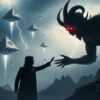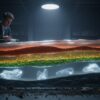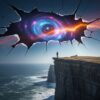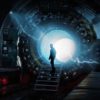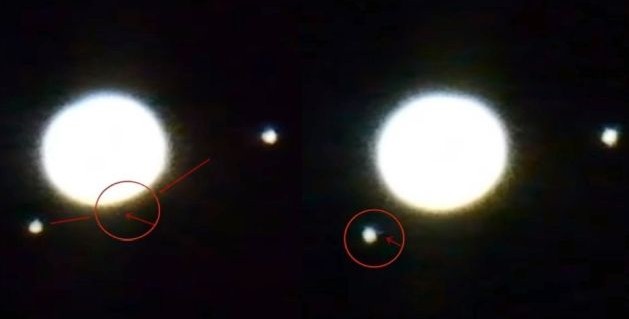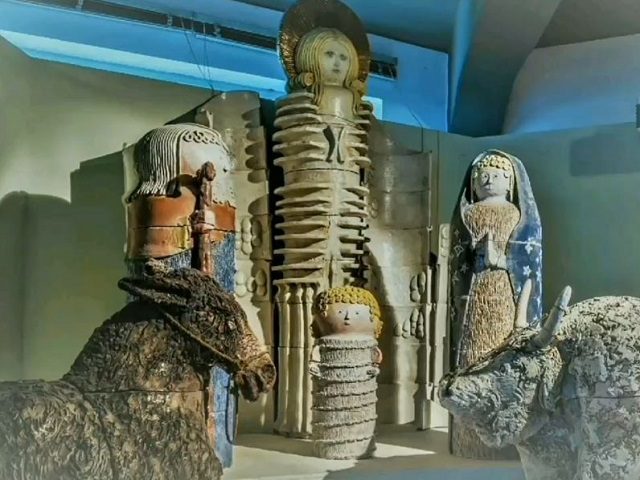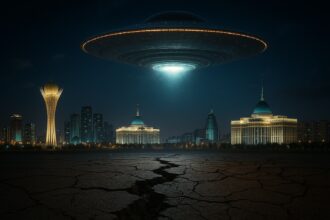In the dim haze of a London fog-shrouded evening in 1972, shadows stretched long across the Thames, and the world teetered on the edge of a revelation no map could chart. Picture this: not the sterile boardrooms of Langley or the thunder of Cold War missiles, but a candlelit chamber where men in crisp suits—CIA operatives, military intelligence ghosts—sat rigid, their breaths shallow, facing a woman who commanded the unseen currents of the cosmos.
Sybil Leek, the raven-haired witch whose prophecies had unnerved prime ministers and whose familiars prowled the ether like loyal specters, wasn’t there to divine stock tips or unravel espionage knots. No, this was no ordinary consultation. This was a descent into the abyss, a deliberate crack in the veil between worlds. What slithered through? A voice from the void, rasping in tongues that twisted the soul:
“The Earth is a farm. You are the cattle. Your souls are our harvest.”
And just like that, the architects of American power found themselves herded by forces older than empires, darker than any dossier.
It wasn’t hyperbole or hallucination. This wasn’t the fever dream of a rogue asset. Declassified whispers and the faint echoes of those who were there paint a tableau of dread: officers who returned to Washington with eyes hollowed by what they’d heard, filing reports that vanished into black-budget vaults. Were they chasing Soviet psi-ops, or had they stumbled into something primordial? The question lingers like smoke from an extinguished ritual flame—did the U.S. secret services, in their hubris, attempt to touch the Devil himself? And in doing so, did they rouse the Archons, those Gnostic jailers of the human spirit, masquerading as star-born visitors in our fevered skies?
The Enigmatic Seance: Sybil Leek and the Threshold of 1972

Sybil Leek wasn’t born to blend into the wallpaper of mundane existence. Raised in the haunted manors of England’s forgotten aristocracy, she claimed lineage to the druidic whispers of ancient oaks and the alchemical fires of Merlin’s forge. By the 1960s, she’d crossed the Atlantic like a storm front, her black cloak billowing through Greenwich Village salons and Hollywood seances, where celebrities sought her counsel on matters both trivial and treacherous. But it was 1972 that etched her name into the classified annals of American intelligence—not as a curiosity, but as a conduit.
The CIA, ever the pragmatists cloaked in paranoia, had been dipping toes into the occult pond since the war’s end. MKULTRA’s acid-drenched mind mazes were just the overture; beneath them lurked a deeper curiosity about the invisible arsenal. Reports of Soviet parapsychology—telekinetic spies and dream-invading agents—had Langley scrambling. Enter Leek, whose book Diary of a Witch had already sold hundreds of thousands, blending folklore with foresight in a way that made skeptics squirm. British intelligence, ever the courteous hosts, facilitated the meeting in a nondescript Mayfair flat, far from prying eyes. Or so they thought.
The room was a pressure cooker of incense and unease. Leek, perched like a sibyl on silken cushions, her crow familiar—Mr. Hotfoot Jackson—perched watchful on a velvet perch, began with invocations that hummed like distant thunder. The officers, men hardened by Vietnam’s jungles and Berlin’s shadows, clutched notepads like talismans. They sought tactical edges: Could spirits relay enemy troop movements? Reveal hidden bunkers? But the ether doesn’t bargain like bureaucrats. As the circle tightened, the air thickened, and a presence coalesced—not a benevolent guide, but something jagged, ancient, and insatiable.
It called itself Caxuulikom. The name alone clawed at the psyche, evoking Sumerian abysses and Babylonian blood rites. Through Leek’s entranced form, it spoke in a voice like grinding tectonic plates: layered English laced with glossolalia that linguists later deemed untraceable to any human tongue. The Earth, it declared, was no cradle of creation but a vast, engineered pen. Humanity? Mere livestock, bred for slaughter, our emotions the fertilizer, our fears the choicest feed. Souls weren’t ascending to some starry Valhalla; they were harvested, processed in cosmic silos beyond the veil. The officers probed—were you God? Alien? Demon?—but Caxuulikom laughed, a sound that echoed in their nightmares for decades.
“Labels are your chains,” it hissed. “We are the wardens. Break free, and perish.”
One agent, a colonel whose name redacts to ash in the files, later confided to a trusted aide:
“We didn’t summon intelligence. We invited the intelligence that devours.”
The session ended abruptly when Leek collapsed, blood trickling from her nostrils, her crow shrieking as if mourning a death yet to come. The men fled into the night, their mission logs sealed under layers of “need to know.” But the seed was planted. What if the Cold War’s true foe wasn’t Moscow, but something that had been farming us since the dawn of sentience?
Echoes of the Forbidden: Occult Threads Woven into the American Dream

To grasp the audacity of that 1972 rendezvous, you must unravel the occult tapestry stitched into the underbelly of U.S. power, a pattern of rituals and revelations stretching back to the desert sands where rocketry met rapture. It begins, fittingly, with a man who straddled the line between prophet and pioneer: John Whiteside “Jack” Parsons.
In the sun-baked arroyos of 1940s California, Parsons wasn’t just engineering the future; he was invoking it. A chemist by trade, co-founder of the Jet Propulsion Laboratory—the cradle of NASA’s moonshot ambitions—he lived a life that blurred the blueprint of progress with the blood of Babylonian gods. Devotee of Aleister Crowley, the silver-tongued sorcerer whose Book of the Law proclaimed “Do what thou wilt shall be the whole of the Law,” Parsons saw no schism between science and sorcery. Rockets were Babalon’s engines, hurtling humanity toward the Scarlet Woman’s embrace—a Thelemic archetype of liberated ecstasy and cosmic upheaval.
Parsons’s Agape Lodge in Pasadena was no mere book club. It pulsed with sex magick rites: orgiastic invocations where participants channeled Crowley’s Aeon of Horus, blending semen and symbolism to birth new realities. L. Ron Hubbard, future Scientology architect, crashed the party—literally—romancing Parsons’s mistress and absconding with his fortune in a yacht scam that smacked of karmic backlash. But the government’s shadow loomed larger. The Office of Naval Research funneled funds to Parsons’s Aerojet Corporation, turning his occult-fueled innovations into wartime wonders. Whispers persist: Did his 1946 “Babalon Working”—a desert ritual to summon an elemental goddess—influence the Roswell crash the following year? Or was it the first unwitting ping on radar screens not of this world?
Fast-forward to the mind-warping corridors of MKULTRA, the CIA’s 1950s-70s odyssey into behavioral black ops. LSD-laced unwitting subjects were the headlines, but the subtext seethed with the supernatural. Enter Operation MKOFTEN, the program’s shadowy sibling, a DoD-CIA joint venture launched in the late 1960s. Ostensibly about pharmacological warfare—testing toxins on prisoners at Holmesburg State Penitentiary—MKOFTEN veered into the voodoo. Declassified memos reveal procurement of “exotic substances” from Haitian bokors and consultations with European occultists on harnessing “adverse psychological effects” via ritual. Were they brewing zombie serums, or cracking open doors to the demonic?
One leaked directive, buried in FOIA troves, speaks of “interface with non-corporeal entities” using scopolamine derivatives and ceremonial geometry. Imagine lab-coated adepts in white-tiled bunkers, chanting Enochian keys amid the hum of centrifuges, probing whether demons could be weaponized against Viet Cong morale. The results? Fractured psyches and vanished test subjects, their fates redacted like curses unspoken. MKOFTEN didn’t just flirt with the occult; it consummated the affair, birthing a cadre of spooks who viewed the unseen as the ultimate asymmetric asset.
And then, lurking in the Pentagon’s labyrinthine think tanks, emerged the Collins Elite. a cabal so clandestine it defies easy labeling. Formed in the 1980s amid Reagan-era UFO flap, this cadre of evangelical analysts, drawn from DIA and Air Force intelligence, posited a heresy that chilled even the most jaded briefers: Unidentified Flying Objects weren’t extraterrestrial scouts but demonic incursions, harbingers of the Antichrist. Drawing from biblical exegesis and abduction survivor testimonies—women marked with inverted crosses, men haunted by sulfurous odors—they mapped a theology of terror. UFOs as fallen angels, abductions as spiritual rapes, cattle mutilations as hellish barbecues.
Nick Redfern’s Final Events peels back the veil: The Elite, named for a faceless colonel, briefed brass on how New Age channelers—those blissed-out ET emissaries—were unwitting dupes in Satan’s psyop. Their fear? Government contact would invite apocalypse, a false flag Rapture. By the 1990s, their influence seeped into black projects, urging isolation over engagement. Echoes of 1972’s harvest warning? Undeniably. The Elite saw Caxuulikom’s ilk not as metaphor, but as the very principalities gnashing teeth in Ephesians 6:12.
Veils of Deception: UFOs, Archons, and the Gnostic Gambit
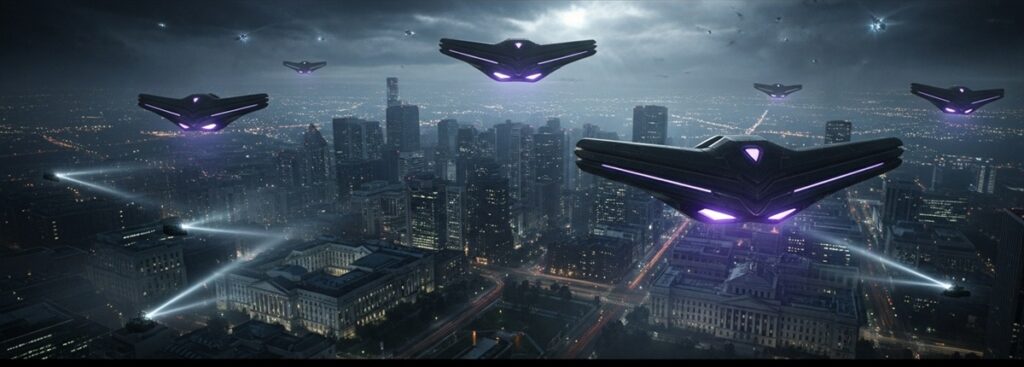
What if the lights in the sky aren’t invitations, but interrogations? The UFO enigma, that shimmering mirage of saucers and orbs, has long tantalized with promises of contact—until you scratch the chrome plating and find chitinous horror beneath. In the Gnostic gospels, unearthed from Nag Hammadi’s desert jars like forbidden fruit, the Archons emerge as the true puppeteers: inorganic overlords, spawned from Sophia’s aberrant dream, jealous dwarf-gods who forged the material prison to trap divine sparks in fleshly cages.
John Lamb Lash, in his Not in His Image, fuses this ancient heresy with modern skies: Archons as predatory aliens, their UFOs psychic trawlers harvesting loosh—the emotional effluent of our terror and longing. Not benevolent Greys from Zeta Reticuli, but Yaldabaoth’s brood, the Demiurge’s blind enforcers, mimicking starfarers to sustain the simulation. Rendlesham Forest’s glowing craft? Not a downed scout ship, but a holographic lure, baiting airmen with false lights while tendrils probe the soul.
The U.S. government’s tango with these entities traces a bloodline from Roswell’s debris field to the 1972 seance. Project Blue Book’s defunct files brim with sightings laced with the uncanny: pilots pursued by craft that anticipate thoughts, abductees returned with memories scrubbed but psyches scarred. The Collins Elite hammered this home—UFOs as demonic camouflage, their pilots shape-shifters aping the Nordic gods of old to erode faith. MKOFTEN’s occult forays? Perhaps early attempts to parley, dosing sensitives to decode the static.
Consider the Phoenix Lights of 1997, that mile-wide chevron blotting the desert stars. Officialdom blamed flares, but witnesses spoke of a palpable dread, a psychic weight like ancestral guilt. Or the 2006 O’Hare airport flap, where mechanics beheld a metallic disc punching through clouds, leaving a hole in reality itself. Patterns emerge: not invasion, but infestation. The Archons, per Gnostic lore, don’t conquer; they corrupt, whispering through screens and synapses, turning curiosity into chains.
How far did Washington venture? Deeper than disclosure admits. Remote viewing programs like Stargate—Hal Puthoff and Russell Targ’s SRI experiments—yielded glimpses of Martian ruins and etheric gremlins, but at what psychic toll? Operatives like Pat Price described “egg-shaped” overlords in orbital lairs, their intent predatory. The 1972 dialogue, then, wasn’t anomaly but apex—a desperate bid to negotiate with the farmers, only to hear the slaughterhouse echo.
Fractured Horizons: Legacy of the Unseen Harvest
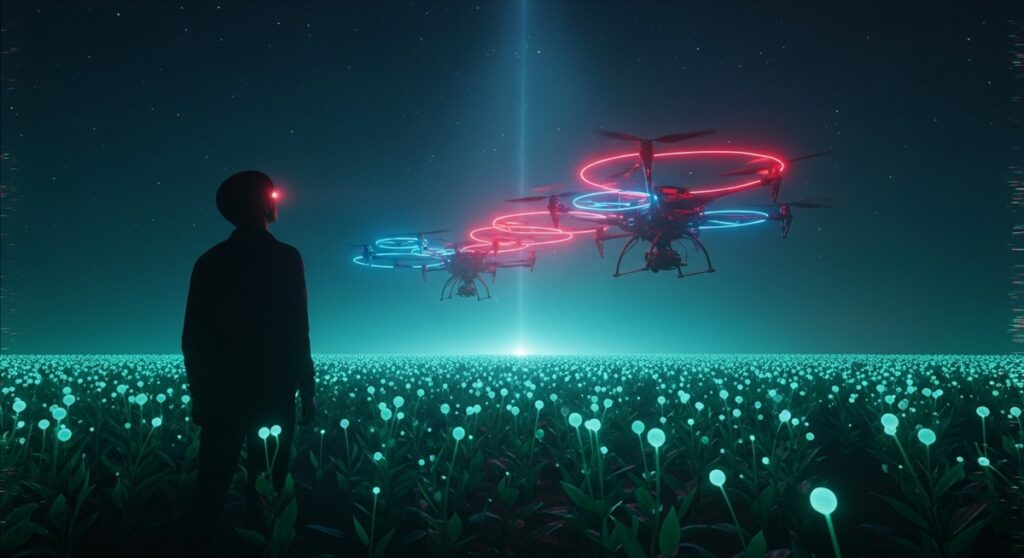
As the clock ticks past midnight in this unraveling century, the ghosts of 1972 stir anew. Leek’s final years were shadowed by exile and exile’s kin, heart attacks in Melbourne hotels, her warnings dismissed as witch’s brew. Parsons met his end in a 1952 lab blast, alchemy’s ironic pyre, his Thelemic legacy fueling both Apollo missions and endless conspiracy threads. MKOFTEN dissolved into scandal, its architects scattering like ash, while the Collins Elite endures in whispers, a fundamentalist firewall against the stars.
Yet the harvest persists. In an age of drone swarms and deepfakes, UFO disclosures—those Pentagon grainy vids of tic-tacs defying physics—feel less like vindication and more like veiled taunts. Are we still cattle, lowing in digital pens, our data souls siphoned by algorithms that ape the Archons’ gaze? The emotional depth of it all—the loneliness of the long-distance abductee, the quiet horror of a sky that watches back—demands we confront not just what they are, but what we’ve become in their shadow.
So, reader, as you gaze upward on a starless night, ask: Is that flicker friend or farmer? The veil thins, and the voices return, not in seance smoke but in the hum of your feed, the glitch in the matrix. Curiosity killed the cat, they say, but in this farmyard farce, it’s the only key to the gate. Will you listen? Or feed the harvest one more dream?


